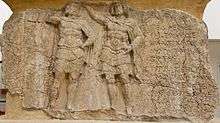Tomb of Payava
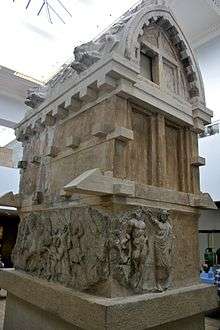 Upper part of Payava's tomb in the British Museum | |
| Location | Originally Xanthos, Lycia, Persian Empire; now British Museum, Room 20 |
|---|---|
| Type | Barrel-vaulted sarcophagus |
| Material | Stone |
| Height | 3.5 metres (11 ft), originally 7.85 metres (25.8 ft)[1] |
| Completion date | 375-360 BC |
The Tomb of Payava is a Lycian tall rectangular free-standing barrel-vaulted stone sarcophagus. It was built in the Achaemenid Persian Empire,[2] for Payava who was probably the ruler of Xanthos, Lycia at the time, in around 360 BC. The tomb was discovered in 1838 and brought to England in 1844 by the explorer Sir Charles Fellows. He described it as a 'Gothic-formed Horse Tomb'.[3]
Payava, who is named in the inscriptions, is only known from this tomb. The tomb is a particularly fine example[4] of a common Lycian style, carved from stone but accurately depicting a wooden structure.[5] The carved friezes on the tomb and its roof contain Greek and Persian features, showing the mix of influences in Xanthos at that time[6] and show:
- Two long-haired and bearded men clothed in cuirasses and cloaks, one of whom may be Payava (South side).
- An athlete and companion dressed in a Greek style (North side).
- A seated figure, in Persian dress receiving a delegation. Possibly the satrap Autophradates receiving Payava (West side).[1]
- Battle of cavalry and foot soldiers (East side and Upper frieze).
- A bear being hunted (Upper frieze).
- Lions (Roof).
- Sphinxes (Pediments).
- Four horses pulling a Greek chariot (Roof).
- A Persian couple (Gable ends).
Three of the four tiers of the tomb are currently housed in the British Museum where they dominate the centre of room 20, the lowest tier was left in Turkey and is in a poor state.[7] Displayed with the tomb are other Greek and Lycian objects from 400–325 BC.
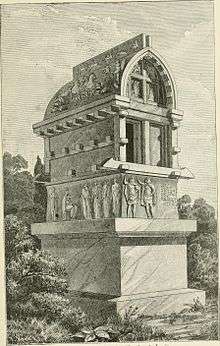 Tomb of Payava at Xanthus in 1905
Tomb of Payava at Xanthus in 1905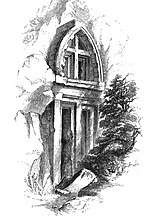 A rock-cut equivalent from Lycia.
A rock-cut equivalent from Lycia.- Side view of the tomb.
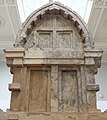 Tomb of Payava front.
Tomb of Payava front.
References
- 1 2 Jenkins, Ian (2006). Greek architecture and its sculpture. Harvard University Press. pp. 179–181. ISBN 0-674-02388-9.
- ↑ Dusinberre 2013, p. 196.
- ↑ "The tomb of Payava, a Lykian aristocrat". British Museum. Retrieved 10 January 2016.
- ↑ Jona Lendering (21 April 2010). "Lycian Tombs". LIVIUS, Articles on Ancient History. Retrieved 6 June 2010.
- ↑ William Bell Dinsmoor; William James Anderson (1973). The architecture of ancient Greece: an account of its historic development. Biblo & Tannen. pp. 67–68. ISBN 0-8196-0283-3.
- ↑ John Curtis; Nigel Tallis; Béatrice André-Salvini (2005). John Curtis, Nigel Tallis, ed. Forgotten empire: the world of ancient Persia. University of California Press. p. 46. ISBN 0-520-24731-0.
- ↑ "Lycia :: Xanthos". exploreTurkey.com. IstanbulNet. Retrieved 6 June 2010.
Sources
- Dusinberre, Elspeth R.M. (2013). Empire, Authority, and Autonomy in Achaemenid Anatolia. Cambridge University Press. ISBN 978-1107018266.
- British Museum information board in room 20
Further reading
| Wikimedia Commons has media related to Tomb of Payava. |
- L. Allen, The Persian Empire: A History (London, British Museum Press, 2005)
- M. Caygill, The British Museum A-Z companion (London, The British Museum Press, 1999)
- E. Slatter, Xanthus: Travels of Discovery in Turkey (London, Rubicon Press, 1994)
- A.H. Smith, A Catalogue of Sculpture in the Department of Greek and Roman Antiquities, British Museum Vol. 2 (London, British Museum, 1900)
- This article is about an item held in the British Museum. The object reference is GR 1848.10-20.142 (Sculpture 950).
